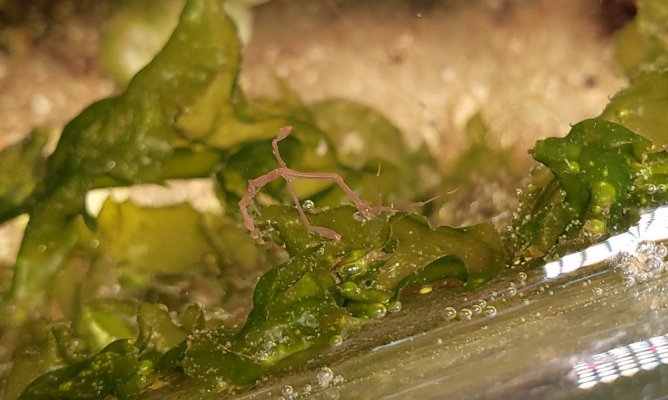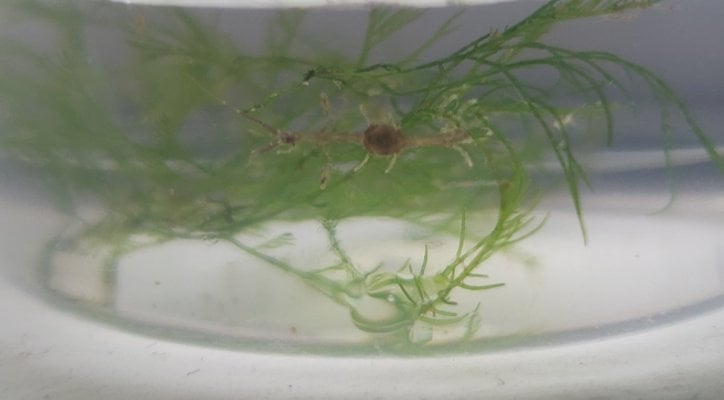This post is to document the presence of Japanese Skeleton Shrimp (Caprella) in Atlantic waters.
Let's start with, what on earth is a skeleton shrimp?
Fair question to be sure, as I've had to ask the same thing recently. Skeleton Shrimp is a bit of a misnomer as they are actually classified as amphipods, and not shrimp. Caprella are a filter feeding invertebrate. They have a stick insect body with very long akward raptorial arms that they often splay in a "T-Pose" to assert dominance over the reef.
These appendages seem to have a multitude of uses from climbing to fighting. The appendages also contain a potent venom they can use to subdue predators.
Most of their time seems to be spent bending back and forth with T Posing arms in an effort to captire food particles, however I have observed them capturing loose strands of algae and hair (mostly my cats) and cleaning the detritus off of them by wiping it through their filtering appendages.
I find they enjoy hanging out on bryopsis and macro hydroid chains. If those aren't present they'll look for anything thin and branching to hang off of to perform their feeding dance.
The females of the species have a little pouch where they host their alien eggs. And of course since these are beyond strange they are born as miniature adults so they have no larval phase. Weird enough? Listen to this.
The juvenile Skeletons will cling to the adults until they're large enough. Just imagine one of these things literally covered in tiny wiggling miniature versions of themselves.
The males are significantly larger than the females and can be easily identified from their size and larger antennae.
The males seem to be fairly aggressive when threatened by an equally sized organism, however they don't seem particularly aggressive towards eacother.
I had the opportunity to witness the mating process. The male seems to initiate mating by wriggling their antennae with the female in between. The female responds by waiving her body back and forth and at some point this seems to confirm for the male to copulate which he does by mounting her and connecting their perching legs.
These were collected from the Intercostal near Boca Raton as hitchhikers on a chain of hydroids. It's odd (but unsurprising) to see them this far from Asia and Europe. However Florida and her waters are a perfect habitat for any invasive and weird species looking for shelter. The most prevalent invasive species currently are Newyorkers.

Let's start with, what on earth is a skeleton shrimp?
Fair question to be sure, as I've had to ask the same thing recently. Skeleton Shrimp is a bit of a misnomer as they are actually classified as amphipods, and not shrimp. Caprella are a filter feeding invertebrate. They have a stick insect body with very long akward raptorial arms that they often splay in a "T-Pose" to assert dominance over the reef.
These appendages seem to have a multitude of uses from climbing to fighting. The appendages also contain a potent venom they can use to subdue predators.
Most of their time seems to be spent bending back and forth with T Posing arms in an effort to captire food particles, however I have observed them capturing loose strands of algae and hair (mostly my cats) and cleaning the detritus off of them by wiping it through their filtering appendages.
I find they enjoy hanging out on bryopsis and macro hydroid chains. If those aren't present they'll look for anything thin and branching to hang off of to perform their feeding dance.
The females of the species have a little pouch where they host their alien eggs. And of course since these are beyond strange they are born as miniature adults so they have no larval phase. Weird enough? Listen to this.
The juvenile Skeletons will cling to the adults until they're large enough. Just imagine one of these things literally covered in tiny wiggling miniature versions of themselves.
The males are significantly larger than the females and can be easily identified from their size and larger antennae.
The males seem to be fairly aggressive when threatened by an equally sized organism, however they don't seem particularly aggressive towards eacother.
I had the opportunity to witness the mating process. The male seems to initiate mating by wriggling their antennae with the female in between. The female responds by waiving her body back and forth and at some point this seems to confirm for the male to copulate which he does by mounting her and connecting their perching legs.
These were collected from the Intercostal near Boca Raton as hitchhikers on a chain of hydroids. It's odd (but unsurprising) to see them this far from Asia and Europe. However Florida and her waters are a perfect habitat for any invasive and weird species looking for shelter. The most prevalent invasive species currently are Newyorkers.

















